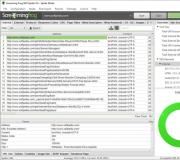Videocacheview doesn't work. How to watch YouTube videos on Android devices offline. Using the Pushbullet service
VideoCacheView is a utility that allows you to extract video files from the browser cache that are stored there when watching videos on the network.
Scans the contents of the browser cache (currently supports browsers, and), and if it finds video files there, it will provide you with the opportunity to copy them to the selected folder for further viewing at any time convenient for you. Or you can watch this video directly from the browser cache (assuming you have a media player on your system that can play .flv files).
Doesn't require installation for its work.
In addition to video, it supports viewing almost any multimedia files in the cache, including pictures.
Known Issues and Limitations
- on some websites, video files are not always stored in the browser cache. In this case, you will not be able to save it to another folder or view it again directly from the cache;
- if you are using a Mozilla-based browser (including Firefox), VideoCacheView will provide a direct download link for this video, even if the file itself was not cached. Due to technical limitations, this feature is not available for Internet browser Explorer;
- for browsers based on Mozilla (including Firefox), you must first close the browser to view the last video files you downloaded.
If the media file is not saved in the cache, you can open its properties ( right click mouse) and select the option to copy a direct link to it, in order, for example, to paste this link into your download manager and force the file to be downloaded.
ATTENTION . To Russify the program, download the archive with the Russian language file. Unpack it and put the VideoCacheView_lng.ini file in the VideoCacheView folder.
All data that we somehow download from the Internet is stored in the browser cache. This is done in order not to download data from the web page every time, but to download only the information that has changed since the last entry to the site for loading speed and saving traffic. There is no exception for videos from the global network. How to get a video from the browser cache - this can be done in two ways - go to the cache folder and find the desired video file there, or use special software.
How to get a video from the browser cache yourself
Option 1 - looking for a file manually
To do this, you need to know where each of the browsers temporarily stores information from web pages.
- Google Chrome:
Navigate to the following path: C: \ Users \ Username \ AppData \ Local \ Google \ Chrome \ User Data \ Cache. If you do not see the AppData folder, then you need to enable the display hidden files and folders (Control Panel - Folder Options - View - Show hidden files and folders). 
Find desired file and open it with the right mouse button and "Open With". 
- Opera:
The cache of this browser is located here: "C: \ Users \ Username \ AppData \ Local \ Opera Software \ Opera Stable \ Media Cache". 
Alternative option- type in the address bar: about: cache, select the desired file format and click "Preview all".
- Mozilla Firefox:
In the address bar, enter about: cache - In the "Drive" section, the path to the cache folder is indicated. If you click on the link "List Cache Entries" - the contents of the cache will open in the browser window.
Option 2 - we use specialized software
To help you parse the cache, the VideoCacheView program is a good choice. Sort files by name (Filename) or by content (Content Type). 
Right-click on the desired file and select "Play file as ..." 
Select a player and watch the video.
After watching a video on the Internet, it is saved in the browser cache, and if necessary, you can get it from there. The main thing is that the browser does not delete it to save disk space. But different browsers (Google chrome, Internet Explorer, Opera, Mozilla FireFox) store cache files in different folders.
I will not suggest looking for these folders and finding cached files there, since you can pull a video from there using the wonderful VideoCacheView program. Unlike other cache viewers, VideoCacheView is tailored specifically for video files. True, the program is in English, but it is very simple and free 🙂
Installing the VideoCacheView program
You can download the program on the official website at the very bottom of the page under the link “Download VideoCacheView in zip file”.
There is a 64-bit version below. Windows versions... The program does not require installation, so you can run it directly from the archive or previously. But if you are used to installing programs with shortcuts on the desktop, you can download the program from the link "Download VideoCacheView with install / uninstall support" on the download page.
Copy video from cache
Feel free to launch the miracle program and wait a few seconds while it scans the found cache files on the computer. After the end of the scan, we see a table of search results:

We are interested in several columns:
- In Cache - if it is "YES" then the video is present in the cache, "No" - if it is absent (the position is highlighted in pink)
- Download URL - link to the video. If you can't get the video, you can follow the link and watch it on the website. This is handy if you want to find a video, but absolutely flew out of your head where you watched it!
- Title - the title of the page on which the video was watched (may be empty)
- Browser - browser of the found video file.
After scrolling to the right, you will see a few more interesting columns:

- Last Accessed Date - the date the video was viewed in the browser. It is very convenient to sort the results by this column to find the file you want.
- File Size - file size. You can also navigate by this parameter. For example, if the video was long, then the file size will be large.
The sightseeing tour is over. Right-click on the file and select "Copy Selected Files To ..." or click on the icon in the toolbar.

A dialog will appear in which it is enough to specify the path to save the file.

You can try to open the resulting video file with your video player. Most likely, the video will be in FLV or MP4 format, so if you can't open it, then download and try to open the file with it. By the way, the file may not be saved to disk, but simply played from the VideoCacheView program using the green "play" button in the toolbar.
Some files may still not open. This means that they were too cleverly stored in the cache. If the video is badly needed, then you will have to restore it using special programs.
The use of lazy read services, the best of which is Pocket. You simply save the article you are interested in with it, and then calmly view it on any device in your free time, and for this you do not even need a connection to the Internet. I wonder if it is possible to do the same with the content of the YouTube service? After all, it would really be great if the video you need was automatically downloaded to your gadget for later viewing on the way home or anywhere else.
We found two whole ways to do this, which we want to introduce you to in this article.
1. Built-in APP function
The YouTube service provides the ability to delay viewing the videos you need. To do this, in the playback control panel for each video there is a special button "Watch later".
But how do you get this video to automatically download for offline viewing? It turns out not that difficult.
To do this, we will use the function built into the proprietary YouTube client for Android, which, however, not everyone knows about.
- Open up YouTube app on your tablet or smartphone.
- Go to the application settings and go to the "Preload" section.
- Check the box next to "Watch Later".


Now any video you have marked will be automatically saved on your device for later viewing. Caching occurs while the device has access to Wi-Fi and is connected to the Network. Readiness for viewing will be indicated by a small arrow in the lower right corner of the playback window. Unfortunately, there are a few more significant nuances that largely limit the use of this method:
- the video is stored on your device for two days;
- this feature is only available on operating systems not lower than Jelly Bean;
- to play, you will need at least some, even the weakest, access to the Network, so you won't be able to go offline completely.
And finally, the most unpleasant thing is that in latest update Google removed this feature altogether. They seem to be promising to return it after revision, but in the meantime, we can advise you to install YouTube previous version which you will find on this page.
2. YouTube Downloader app
Google is very negative about any attempts to download videos from YouTube, so it regularly removes the corresponding tools from the app store. Because of this, the program we are interested in will have to be downloaded from the developer's website.
YouTube Downloader, as the name suggests, is designed to save videos to your device. And he does it very quickly, allows you to choose the required format, knows how to extract only sound track etc. In addition, we will need a simple recipe for the IFTTT service, which can send a link to a video of interest to your smartphone or tablet. This can be done in several different ways.
By email:
Through the Pocket service:
Using the Pushbullet service:
After the link to the video has somehow ended up on your device, you need to send it to the YouTube Downloader application. It is very easy to do this with standard menu"Send". After that, you just have to choose the desired format and save the file on your device for later viewing.


Each of the proposed methods has its own advantages and disadvantages. The first one works completely automatically, but it implies a number of restrictions. The second one requires you to perform several additional steps, but it works quite reliably. So the final choice is, of course, yours.
Maybe you know another way to watch YouTube videos offline?
After watching a video on the Internet, it is saved in the browser cache. This is good as it can be replayed if necessary. The main thing is that the browser does not delete it to save disk space.
However, it's worth noting that each browser stores cache files in different folders. Therefore, in order to get a video from the cache, you should read some of the recommendations.
How to get a video from the cache in Google Chrome?
To get a video from the cache in Google Chrome, you need to open the C drive, the Users folder and the folder with your name (nickname).

It should be noted that to gain access to this folder, you need to configure the display of hidden files. To do this, in the "Computer" press "Organize" and select "Folder and Search Options".

Go to the "View" tab and select "Show hidden folders and files."

Now in the "Cache" folder, select the desired file and open it through the player.

To do this, right-click and click "Open with ...".

We select the player and watch the video.
How to get videos from cache in Opera?
Cache Opera browser located at the following address: drive "C", folder "Users", then "User" (nickname or name) and the folder "AppData", "Local", "Opera Software", "Opera Stable", "Media Cache".

However, you can access the video cache in a more convenient way. To do this, just enter "about: cache" in the browser search bar.


How do I get a video from the cache in Mozilla?
To find out the location of the cache Mozilla browser, you must enter in the address bar of the browser following lines: "About: cache".

We look at the "Disk" section. This is where the cache folder is indicated.


How to get a video from the browser cache using the program?
In order to get a video from the cache, you can use a simple and understandable program - VideoCacheView.



